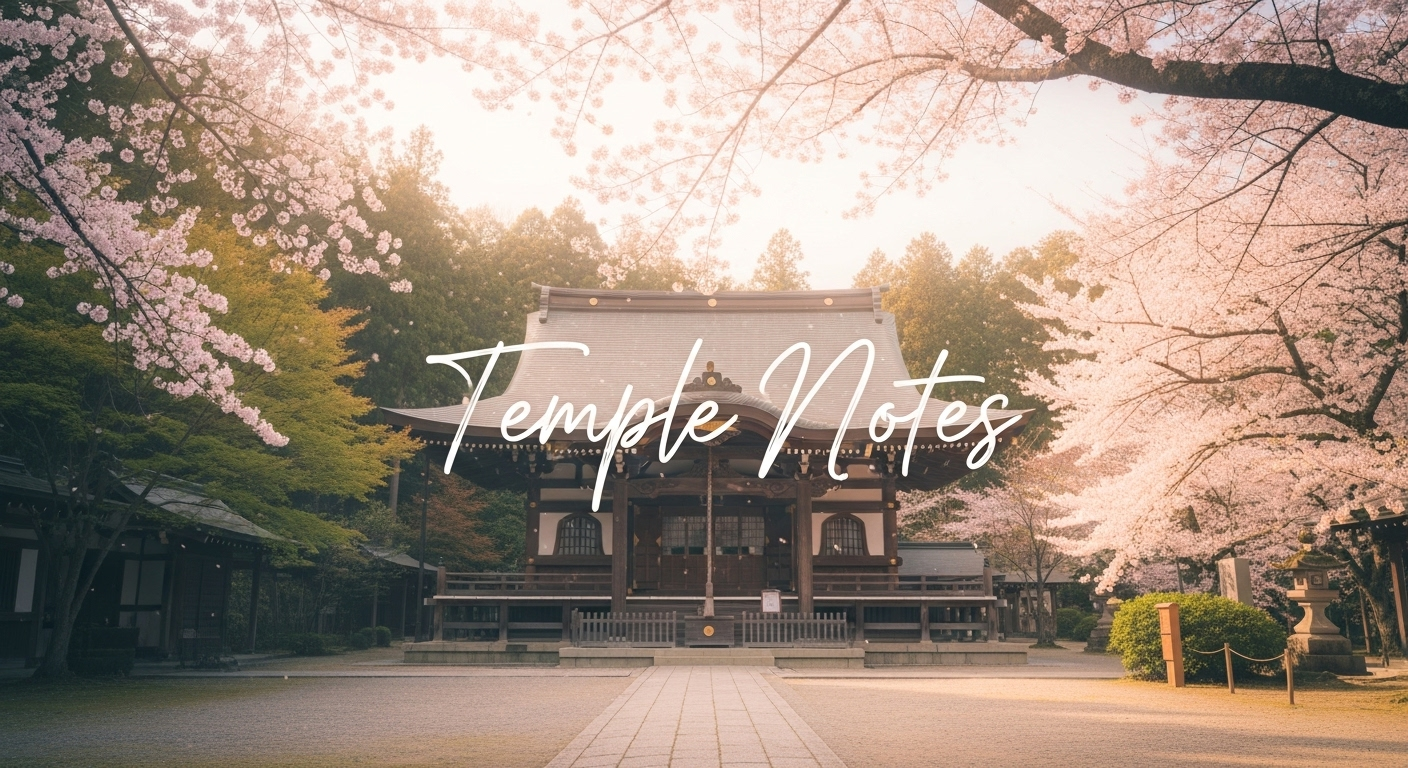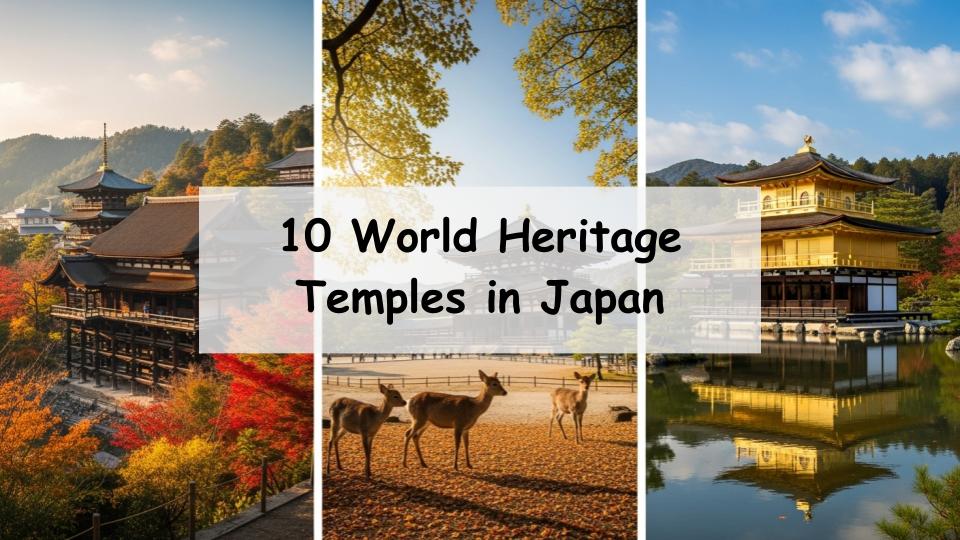Japan is home to many magnificent UNESCO World Heritage temples, each showcasing the country’s deep spirituality, history, and artistic heritage.
You might be wondering, “Which temples in Japan are listed as World Heritage Sites?” or “What makes these temples worth visiting?”
In short, Japan’s World Heritage temples are not only of historical importance—they embody harmony between architecture, nature, and faith.
This article introduces 10 must-visit World Heritage temples in Japan, highlighting their unique features, cultural significance, and travel tips. Whether you’re planning your next trip or simply seeking spiritual inspiration, you’ll find the perfect temple destination here.
- What Is a World Heritage Site? Why Temples Are Chosen
- 10 UNESCO World Heritage Temples in Japan
- 1. Kiyomizu-dera (Kyoto) | A Stage with a View and Centuries of History
- 2. Todai-ji (Nara) | Home to the Great Buddha, Symbol of Ancient Nara
- 3. Kinkaku-ji (The Golden Pavilion, Kyoto) | The Radiant Beauty of Paradise
- 4. Ginkaku-ji (The Silver Pavilion, Kyoto) | Serenity and the Essence of Wabi-Sabi
- 5. Enryaku-ji (Mount Hiei, Shiga) | A Thousand Years of Buddhist Tradition
- 6. Horyu-ji (Nara) | The World’s Oldest Wooden Architecture
- 7. Mount Koya (Wakayama) | The Sacred Mountain of Shingon Buddhism
- 8. Chuson-ji (Iwate) | The Golden Hall and the Glory of Hiraizumi
- 9. Motsu-ji (Iwate) | A Pure Land Garden of Tranquility and Faith
- 10. Byodo-in (Kyoto) | The Phoenix Hall and the Elegance of the Pure Land
- What to Know Before Visiting World Heritage Temples
- Model Itineraries for Visiting World Heritage Temples
- Conclusion | Experiencing Japan’s Spirit Through Its World Heritage Temples
- A Message from the Guide
What Is a World Heritage Site? Why Temples Are Chosen
Definition and Categories of World Heritage
A World Heritage Site, as designated by UNESCO, is a place recognized for its outstanding cultural or natural value to humanity. In the case of temples, they are often chosen for their historical significance, architectural excellence, and the preservation of spiritual traditions that transcend generations.
Why Temples Are Inscribed as World Heritage
Temples become World Heritage Sites because they represent universal human values such as faith, artistry, and harmony with nature. Their intricate wooden structures, centuries-old rituals, and integration into surrounding landscapes exemplify exceptional craftsmanship and religious devotion. These qualities ensure their preservation as symbols of shared cultural heritage.
Characteristics of Japanese World Heritage Temples
Japanese World Heritage temples are distinctive for their wooden architecture, gardens designed in harmony with nature, and aesthetic of simplicity and balance. From grand urban temples to secluded mountain sanctuaries, each reflects Japan’s unique blend of spirituality and artistry.
10 UNESCO World Heritage Temples in Japan
1. Kiyomizu-dera (Kyoto) | A Stage with a View and Centuries of History
Famous for its massive wooden terrace known as the “Kiyomizu Stage,” Kiyomizu-dera offers breathtaking panoramic views of Kyoto. Built without nails, the temple’s architectural mastery is awe-inspiring. The approach to the temple is lined with charming shops, and the nearby Otowa Waterfall adds to the spiritual experience.
2. Todai-ji (Nara) | Home to the Great Buddha, Symbol of Ancient Nara
Todai-ji stands as a symbol of Japan’s Nara Period, housing one of the largest bronze Buddha statues in the world. The temple complex includes monumental gates and wooden halls that exude grandeur. Located within Nara Park, it’s also famous for the friendly deer that roam freely around the area.
3. Kinkaku-ji (The Golden Pavilion, Kyoto) | The Radiant Beauty of Paradise
Covered entirely in gold leaf, Kinkaku-ji reflects dazzlingly in the surrounding pond, representing the Buddhist concept of paradise. The temple’s garden design creates a picturesque harmony that changes beautifully with each season. Easily accessible from Kyoto’s city center, it’s a must-see cultural icon.
4. Ginkaku-ji (The Silver Pavilion, Kyoto) | Serenity and the Essence of Wabi-Sabi
Ginkaku-ji embodies the refined simplicity of Japanese aesthetics. Unlike its golden counterpart, the Silver Pavilion emphasizes tranquility and the beauty of imperfection. The surrounding Zen gardens and nearby Philosopher’s Path make it a peaceful retreat amid Kyoto’s cultural district.
5. Enryaku-ji (Mount Hiei, Shiga) | A Thousand Years of Buddhist Tradition
Perched on Mount Hiei, Enryaku-ji is the headquarters of the Tendai sect and a vital training ground for monks for over 1,200 years. Its vast complex of temples blends seamlessly with the forested mountain. The site is reachable via cable car or bus, making it ideal for a spiritual day trip.
6. Horyu-ji (Nara) | The World’s Oldest Wooden Architecture
Horyu-ji preserves wooden structures dating back to the 7th century, making it the world’s oldest surviving wooden architecture. Every beam and column tells a story of Japan’s early Buddhist art and technical ingenuity. It remains an essential destination for anyone interested in Japan’s architectural origins.
7. Mount Koya (Wakayama) | The Sacred Mountain of Shingon Buddhism
Founded by Kobo Daishi (Kukai), Mount Koya serves as the heart of Shingon Buddhism. The vast temple complex and Okuno-in Cemetery are enveloped in an atmosphere of deep spirituality. Visitors can stay overnight in temple lodgings (shukubo) and experience meditation and morning prayers.
8. Chuson-ji (Iwate) | The Golden Hall and the Glory of Hiraizumi
Chuson-ji’s Konjikido (Golden Hall) is an opulent masterpiece covered in gold leaf, symbolizing the prosperity of the Hiraizumi culture. Surrounded by serene forests, the temple offers a quiet, reflective experience. Seasonal beauty—from cherry blossoms to autumn leaves—enhances its allure.
9. Motsu-ji (Iwate) | A Pure Land Garden of Tranquility and Faith
Motsu-ji is renowned for its Pure Land-style garden, designed to represent the Buddhist vision of paradise. The balance of ponds, stones, and greenery evokes peace and contemplation. Visiting both Motsu-ji and Chuson-ji offers deep insight into the cultural sophistication of ancient Japan.
10. Byodo-in (Kyoto) | The Phoenix Hall and the Elegance of the Pure Land
Byodo-in’s Phoenix Hall, immortalized on Japan’s 10-yen coin, is a stunning example of Heian-period architecture. The reflection of the hall in the pond symbolizes the Buddhist Pure Land. Detailed carvings and vibrant paintings make it one of Kyoto’s most refined and accessible heritage sites.
What to Know Before Visiting World Heritage Temples
Visiting Etiquette and Considerations
World Heritage temples are sacred spaces and living places of worship. Visitors should maintain quiet voices, avoid eating in temple areas, and follow instructions regarding restricted zones. Photography rules vary, so always check posted signs before taking pictures. Respectful behavior ensures preservation of the atmosphere and the heritage itself.
Best Seasons and Tips to Avoid Crowds
Spring and autumn are the most popular times for temple visits, thanks to cherry blossoms and fall foliage. To avoid crowds, visit early in the morning or on weekdays. Winter brings calm serenity, while summer offers lush greenery. Always check temple schedules in advance, as some areas may close seasonally.
Photography and Goshuin (Temple Stamp) Etiquette
Many temples prohibit indoor photography, especially of sacred statues. When collecting goshuin (temple stamps), approach quietly and wait patiently in line. Treat your goshuin book with care—it’s both a travel memento and a spiritual record of your journey.
Model Itineraries for Visiting World Heritage Temples
Kansai Route | A Journey Through History and Culture
The Kansai region—home to Kyoto and Nara—boasts the highest concentration of World Heritage temples in Japan. A one-day route could include Kiyomizu-dera in the morning, followed by Kinkaku-ji and Ginkaku-ji in the afternoon. Efficient public transport and walkable routes make it easy to explore multiple sites in a day.
Tohoku Route | Tracing the Peace and Beauty of Hiraizumi
In northeastern Japan, the Hiraizumi area features Chuson-ji and Motsu-ji, both surrounded by scenic countryside. The tranquil atmosphere and historical depth make it perfect for contemplative travel. Combine your visit with nearby hot springs for a relaxing and enriching cultural trip.
Spiritual Japan Route | Following the Path of Faith and Architecture
A pilgrimage through Mount Hiei and Mount Koya reveals the essence of Japanese Buddhism. Staying overnight at a temple lodge offers unique opportunities for meditation and morning rituals. This journey blends spiritual reflection with architectural appreciation.
Conclusion | Experiencing Japan’s Spirit Through Its World Heritage Temples
What Temple Pilgrimage Teaches About the Japanese Spirit
Exploring Japan’s World Heritage temples offers more than aesthetic pleasure—it’s a journey into the heart of Japanese philosophy and faith. The quiet courtyards and timeless architecture convey a deep respect for nature, harmony, and continuity.
Why Your Next Trip Should Include a World Heritage Temple
Each World Heritage temple in Japan embodies centuries of devotion and artistry. Whether you’re drawn by history, spirituality, or architecture, these sacred sites promise inspiration and insight. Visiting them is not just sightseeing—it’s a dialogue with Japan’s enduring cultural soul.
A Message from the Guide

All of them are wonderful temples, but there are still many more World Heritage temples out there.


















Comment